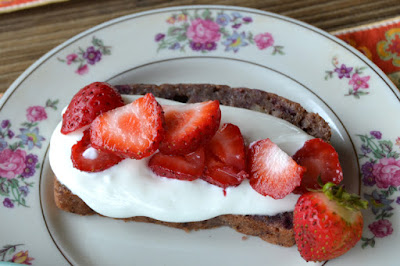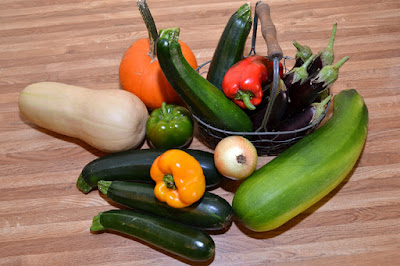This National Geographic Kids book is much more about the history of food than it is a cookbook. The book takes the reader through 15 eras of times, from The Prehistoric Era to the Future World. Each chapter has 10 pages beginning first with a description of the time, the place and what was going on in the world. There is a "day in the life" of a child living in a specific country at the time. There's a chart with common foods eaten at the time, a paragraph on table manners, a page on kitchen tools, 2 recipes and a quiz. The graphics are colorful, the style is both informative and entertaining.
Here are some of the facts or quotes I found most memorable from each era:
- The Prehistoric Era (10,000 B.C.) People ate depending on where they wandered-some were vegetarians, some meat eating.
- Egypt (1300 B.C.) Most houses had an inner courtyard with a garden of fruits, vegetables and flowers.
- Greece (482 B.C.) The term "Dietetics" was coined noting the connection between what one ate and health. Even the poor ate healthy with diets consisting of seafood, produce, olive oil, yogurt and barley bread.
- Rome (30 B.C.) The great empire was built on vegetables. The Romans preserved food by pickling, drying, curing and smoking. Fresh fish was all around in streams, rivers and the sea. The Romans used knives, with pasta machines, braziers and tongs created in that era.
- Medieval England (1450) People ate dependating on how much money or land they had and what grew on or around them. Barley was very easy to grow. The first cookbook Le Viandier was written by the master cook for the King of France in 1300.
- Mongols and the Silk Road (1210) The Mongols rarely ate grains, fruits or vegetables. They ate "ultimate" mobile kitchens, with cast iron cookware and the animals they would eat traveled with them.
- Renaissance (1522) Girls took forever to dress up, with underdress, stockings, corset, bodice, petticoats and heavier dress on top. Typical foods eaten were barley and rye bread and hard cheese. They did not eat vegetables.
- American Revolts (1781) Thomas Jefferson ate a diet consisting primarily of vegetables. (He died at 83). Wood paddles and beehive ovens were common cookware. The "American Cookery" was the first US cookbook.
- French Revolution (1780s) Poor kids worked 12 hours a day. Much of the country ate basic foods, produce and grains. Fruit was usually cooked before eating.
- Industrial Revolution (1822) Kids were fed in factories 3 meals a day. The were given meager bites with few breaks. Gruel, mutton bread and soup were common foods. The potato crop in Europe contracted a disease. About one million Irishman died during the Great Famine.
- World War I (1917) There was wide spread food shortages and volunteer conservation. Meatless Mondays and Wheatless Wednesdays were observed. Ranges and refrigerators made cooking easier. The grocery store Piggly Wiggly opened.
- Great Depression (1932) Social Security, Food Stamps, Minimum Wage, Soup Lines and Penny restaurants brought some relief to the poor and unemployed after the stock market crash.The middle class preferred faster processed foods and sliced breads. Pot Pies and casseroles were common.
- World War II (1942) Women worked. Students received free school lunches. Victory Gardens at the schools gave the kids fresh produce. Canned fish, Cheerios, white bread and highly processed foods were preferred at home.
- Sixties Julia Child encouraged people to discover the joys of cooking at home. The 1964 Worlds Fair introduced international recipes to America. Vegetarianism was growing.
The recipes I tried were all tasty and inclusive of a variety of vegetables or fruit.
"King Tut's Not Fishy Cakes" was made with fish and potatoes. People ate so much fish in Egypt in 1300 BC. This recipes can also be made with leftover fish.
The "Apple of Shakespeare's Eye" was very tasty with only a little honey with raisins and orange zest.
The "Buuz Off Dumplings with Silk Road Sauce" had pork and green vegetables. These were delicious, though my picture did not due them justice.
The "Astronaut Fruitcake" was closely adapted from one the US Army created for astronauts in the mid-1960s. Mine has 1/2 whole wheat and 1/2 all purpose flour and 1/3 cup sugar in stead of 1/2 cup. This was moist and full of walnuts, dates and frozen berries. (I used wild black raspberries I'd picked over the summer).
The recipes weren't easy and required adult supervision.
Thank
you Media Masters Publicity for the complimentary review copy. The above post and
pictures are my own. I received no other compensation for this review,
other than the pleasure of learning the history (with sampling) of the foods over time!
Award-Winning Food Journalist and Originator of Obama
White House’s Annual Kids’ State Dinner Takes a Bite Out of History with New
Book for Kids
“Food Fight!:
A Mouthwatering History of Who Ate What and Why
Through the Ages”
By Tanya Steel
WASHINGTON (June 15, 2018)—This fall,
bestselling author and global food industry leader Tanya Steel takes readers on
a culinary tour of history in “Food
Fight!: A Mouthwatering History of Who Ate What and Why Through the Ages” (National
Geographic Kids; ISBN 978-1426331626; on sale Sept. 11, 2018; $19.99; ages 10
and up). From the discovery of fire a million years ago, to the domestication
of animals in the Neolithic era (15,000 to 2,000 B.C.), to the potential future
of Martian agriculture, Steel looks at history through the lens of food to
answer questions not usually addressed in the classroom. The book also invites
readers to experience the culinary history first-hand with 30 kid-tested,
historically inspired recipes.
Steel is a former editor at Bon Appétit and Food
& Wine, former editorial director of Epicurious, Clean Plates and
Gourmet.com, and an originator of “The Healthy Lunchtime Challenge & Kids’
State Dinner” hosted by former First Lady Michelle Obama at The White House (a
national recipe contest for kids aged 8 to 12 from 2012-2016). Steel was excited
to bring her extensive experience and passion for food to this delicious romp
through the ages.
“I’m so proud of this book,” said Steel.
“National Geographic Kids was the perfect partner for this project. We wanted
to show some of the fascinating meals people used to eat, some of the
interesting ways they gathered ingredients and cooked, and what kids’ lives
were like at important moments in history. We will hopefully inspire younger
readers to learn a bit about history along the way and reach their own goals.
There is a subtle message about eating healthfully, eating real food and being
the best they can be. I can’t wait to see what our brilliant readers might cook
up in the future!”
Each chapter of “Food Fight!” focuses on a major
period of world history – from Prehistoric cave-kids and Ancient Greece, to the
present day and beyond – and examines politics, culture, class differences and
economics as they are reflected in the cuisine du jour. This highly visual
collection is full of colorful sidebars, historical photos, “Yucky Habits of
Yore,” funny quizzes (to get kids to retain their newfound knowledge) and even
wholesome period-inspired recipes – like Cavekid Trail Mix, Let Them Eat
Quiche, and Lentil Stew for Junior Olympiads, among others – that will take
readers’ taste buds back in time. Pairing National Geographic Kids’ unique
blend of humor and history with Steel’s exceptional experience in the culinary
industry, “Food Fight!” is an educational and entertaining guide that is
perfect for foodies, future chefs and history buffs of all ages.
About
the Author
Tanya Steel is a global award-winning food industry
leader. She originated “The Healthy Lunchtime Challenge & Kids' State
Dinner” hosted and helmed by former First Lady Michelle Obama, an annual event
that was held at the White House for five years, and Kid Food Nation in Canada.
Steel is the former editorial director of Epicurious, Clean Plates,
Gourmet Live and Gourmet.com; she was an editor at Bon Appétit and Food &
Wine, and she wrote for The New York Times for four years. She
co-wrote the award-winning Real Food for Healthy Kids and penned The
Epicurious Cookbook, which debuted on The New York Times bestseller
list.
About
National Geographic Kids
National
Geographic Kids teaches kids about the world and how it works, empowering
them to succeed and make it a better place. National Geographic
Kids inspires young adventurers through award-winning magazines,
books, games, videos, events and a Webby Award-winning website, and is the only kids brand
with a world-class scientific organization at its core. Learn more
at https://kids.nationalgeographic.com/ and follow
us on Twitter and Facebook.
About National Geographic Partners LLC
National Geographic Partners LLC
(NGP), a joint venture between National Geographic and 21st Century Fox, is
committed to bringing the world premium science, adventure and exploration
content across an unrivaled portfolio of media assets. NGP combines the global
National Geographic television channels (National Geographic Channel, Nat Geo
WILD, Nat Geo MUNDO, Nat Geo PEOPLE) with National Geographic’s media and
consumer-oriented assets, including National Geographic magazines; National
Geographic studios; related digital and social media platforms; books; maps;
children’s media; and ancillary activities that include travel, global
experiences and events, archival sales, licensing and e-commerce businesses.
Furthering knowledge and understanding of our world has been the core purpose
of National Geographic for 130 years, and now we are committed to going deeper,
pushing boundaries, going further for our consumers … and reaching millions of
people around the world in 172 countries and 43 languages every month as we do
it. NGP returns 27 percent of our proceeds to the nonprofit National Geographic
Society to fund work in the areas of science, exploration, conservation and
education. For more information visit natgeotv.com or nationalgeographic.com,
or find us on Facebook, Twitter, Instagram, YouTube, LinkedIn and Pinterest.


























